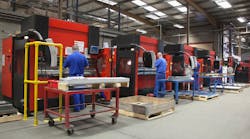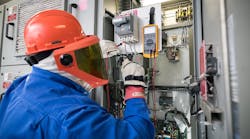What if your production area undergoes fairly frequent reconfigurations? After each one come the inevitable complaints about the lighting, followed by an abundance of task lights plugged in all over the place.
The task lighting does solve the immediate problem for the production workers whose overhead lighting proved inadequate after the equipment moves. But what happened to the formerly adequate light? It’s now being wasted by being in the wrong place, and the “solution” wastes energy by adding energy-consuming task lighting to make up for the lighting misallocation.
If only you had the time and labor resources to pull new lighting circuits to achieve a proper lighting fixture layout for the new conditions. Well, you can have those resources if you change your lighting power distribution system to make it more flexible.
Typically, lighting circuits are run from the breaker to the first luminaire, then to the next luminaire and so on. To reconfigure, you need to run a new circuit all the way from that breaker unless you get lucky with that first luminaire.
But what if you had a modular system instead? What if you ran each of your lighting home-runs from their breakers to a “distribution” box with terminal strips inside?
Situate each “distribution” box in a zone. What’s a zone? It’s the area intended to be covered by a given lighting circuit. Let’s say you have 10 lighting circuits in Building A. Instead of running 10 “fixed in position” circuits to individual luminaires, you install a box in each of 10 zones. Each zone is the area where you’re going to put the lighting, but the problem is determining where exactly the luminaires need to be. The junction box in a zone system lets you solve this problem quickly and cheaply after each reconfiguration or equipment move.
Suppose there’s a reconfiguration in Zone 3. An operator station that had a light over it now does not, so there’s shadow instead of good illumination. No problem. You move the light to be over the operator station, and instead of pulling the whole circuit all the way from the lighting panel, you simply pull a new circuit from the Zone 3 “distribution” box.
This kind of modularity allows you to quickly and cheaply adapt the fixture placement to the new conditions below. You should be able to eliminate most, if not all, task lighting while improving overall user satisfaction with the lighting.





